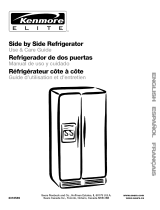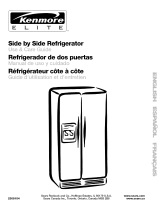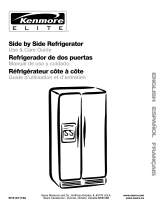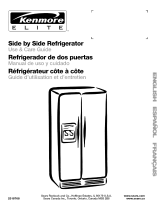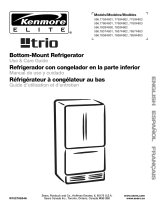
19
Drop-In Door Rails
To Remove and Replace the Rails:
1. Remove the rails by pulling straight up on each end of the
rail.
2. Replace the rails by sliding the shelf rail into the slots on the
door and pushing the rail straight down until it stops.
REFRIGERATOR CARE
Cleaning
Both the refrigerator and freezer sections defrost automatically.
However, clean both compartments about once a month to
avoid buildup of odors. Wipe up spills immediately.
To Clean Your Refrigerator:
1. Unplug refrigerator or disconnect power.
2. Remove all removable parts from inside, such as shelves,
crispers, etc.
3. Hand wash, rinse, and dry removable parts and interior
surfaces thoroughly. Use a clean sponge or soft cloth and a
mild detergent in warm water.
■ Do not use abrasive or harsh cleaners such as window
sprays, scouring cleansers, flammable fluids, cleaning
waxes, concentrated detergents, bleaches or cleansers
containing petroleum products on plastic parts, interior
and door liners or gaskets. Do not use paper towels,
scouring pads, or other harsh cleaning tools. These can
scratch or damage materials.
■ To help remove odors, you can wash interior walls with a
mixture of warm water and baking soda (2 tbs to 1 qt
[26 g to 0.95 L] of water).
4. Determine whether your refrigerator exterior is painted
metal, Ultra Satin™ (stainless look) finish, brushed aluminum
or stainless steel, and choose the appropriate cleaning
method.
NOTE: Ultra Satin™ (stainless look) finish has a smooth,
uniform color with a glossy finish that resists fingerprints.
Stainless steel has a distinct grainy texture with variation in
color that is natural to steel.
Painted metal: Wash exteriors with a clean sponge or soft
cloth and a mild detergent in warm water. Do not use
abrasive or harsh cleaners, or cleaners designed for stainless
steel. Dry thoroughly with a soft cloth. Additionally, to avoid
damage to painted metal exteriors, apply appliance wax
(or auto paste wax) with a clean, soft cloth. Do not wax
plastic parts.
Brushed aluminum: Wash with a clean sponge or soft cloth
and a mild detergent in warm water. Do not use abrasive or
harsh cleaners, or cleaners designed for stainless steel. Dry
thoroughly with a soft cloth.
Ultra Satin™ (stainless look) finish: Wash with a clean
sponge or soft cloth and a mild detergent in warm water. Do
not use abrasive or harsh cleaners, or cleaners designed for
stainless steel. Dry thoroughly with a soft cloth.
Stainless steel finish: Wash with a clean sponge or soft cloth
and a mild detergent in warm water. Do not use abrasive or
harsh cleaners. Dry thoroughly with a soft cloth.
■ To keep your stainless steel refrigerator looking like new
and to remove minor scuffs or marks, it is suggested that
you use the manufacturer’s approved Stainless Steel
Cleaner and Polish. To order the cleaner, see
“Accessories.”
IMPORTANT: This cleaner is for stainless steel parts only!
■ Do not allow the Stainless Steel Cleaner and Polish to
come into contact with any plastic parts such as the trim
pieces, dispenser covers or door gaskets. If unintentional
contact does occur, clean plastic part with a sponge and
mild detergent in warm water. Dry thoroughly with a soft
cloth.
5. If your model has a touch screen display on the dispenser
panel, clean the screen using a soft, lint-free cloth. Mix a
mild detergent with water, then use the mixture to dampen
the cloth and gently wipe the screen.
■ To avoid unintentionally changing settings, make sure the
refrigerator is unplugged or the power is disconnected
before wiping the screen.
■ Do not over-saturate the cloth. Do not spray or wipe
liquids directly onto the screen. Do not use abrasive or
harsh cleaners such as window sprays, scouring
cleansers, flammable fluids, cleaning waxes,
concentrated detergents, nail polish remover, bleaches
or cleansers containing petroleum products. Do not use
paper towels, scouring pads, or other harsh cleaning
tools. These can scratch or damage materials.
6. There is no need for routine condenser cleaning in normal
home operating environments. If the environment is
particularly greasy or dusty, or there is significant pet traffic
in the home, the condenser should be cleaned every 2 to
3 months to ensure maximum efficiency.
If you need to clean the condenser:
■ Remove the base grille. See “Base Grille” graphic or
“Base Grille” section.
■ Use a vacuum cleaner with a soft brush to clean the
grille, the open areas behind the grille and the front
surface area of the condenser.
■ Replace the base grille when finished.
7. Plug in refrigerator or reconnect power.
WARNING
Explosion Hazard
Use nonflammable cleaner.
Failure to do so can result in death, explosion, or fire.




















